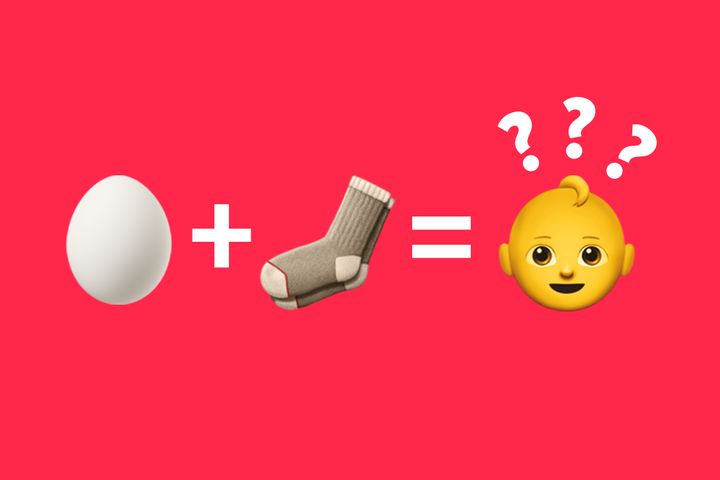
If you’re a parent on the internet, chances are you’ve come across the completely mind-boggling viral Facebook post about an egg in a sock and how it can be used to ease a baby’s teething pain.
The hack – which sees parents pop an uncooked egg in a sock (yes, really) and hang it above their baby’s bed – has been shared left, right and centre on various parenting groups.
Some parents swear by it, others say it’s a load of BS and the rest are caught in between, equal parts intrigued and baffled by it.
So where did the egg sock hack originate?
Turns out it’s been around for years, however mum Kate Garrett brought it to the internet’s attention recently when she shared an update on Facebook about how her baby had stopped sleeping well at night and she’d tried it.
“We ordered different sleep sacks. Tried different bath supplements,” she wrote. “Figured it was a growth spurt, lost our minds for a bit. I asked Axel to hang up an egg sock just in case it was his teeth.”
Apparently their baby slept all night after the egg sock went up – and continued to do so. But then – as all good babies do – he started waking up again. “He’s on solids now so I thought maybe with his growing appetite he wasn’t staying full,” said Garrett.
“Last night I had Axel change the egg out while I gave the baby a bath and got him ready for bed. Last night he slept all night.”
She suggested the method works because “eggs absorb up to seven times their weight in carbon dioxide”. The theory – and it is an unproved theory – is that carbon dioxide puts pressure on the gums. So if you lessen the carbon dioxide in the room, you lessen the pressure, and therefore the pain.
Parents had questions: what was the egg sock? Was it quite literally, an egg in a sock? And what kind of sock – washed, unwashed, did it matter? Was the egg cooked? Raw? How had they fastened the sock to the wall? What happened if the sock fell off the wall? All valid questions, we might add.
There was much debate too. Parents went off to try it – some swore it worked, others said it didn’t do anything. Before long, Garrett was forced to turn off the comments because her post had snowballed into a monster of Ostrich egg-sized proportions.
“Whatever the reason, it’s worked for many parents for many generations,” she wrote in response to increasing negativity towards the post. “Don’t believe it, keep your eggs in the fridge honey and don’t try it. But I really hope it helps some struggling parents along the way.”
Perhaps unsurprisingly, it was quite difficult to find a doctor or scientist who wanted to comment on this one. But there were plenty of sleep-deprived parents willing to try.
When one mum shared the post in a first time parent’s group, many flocked to try it. “My son who’s 14 months hasn’t slept properly in about a month due to teething,” wrote one sleep-deprived parent. “I saw the egg in a sock hack and he slept 7.30-8.15 this morning no wake ups and I feel soo much better. May have been a fluke but it worked.”
Another had the same verdict: “Someone shared the hack of helping teething babies sleep by putting an egg in a sock over the cot. I tried it last night, and for the first time ever in 16 weeks, my boy slept for four-hour stretches and only woke once! I’m hoping that this is not a fluke.”
But many didn’t seem to reap the benefits – much to their disappointment. “I seen this and tried it, don’t think it did anything,” said one mum. “Didn’t work for us! If anything, sleep has been worse since doing it,” added another.
“I actually saw this a few weeks ago and gave it a try,” one parent added. “The egg was with us for a week or so and it didn’t do anything.”
Emily Oster, an economics professor at Brown University and parenting author, dove a bit deeper into the unusual egg sock claims for ParentData after one parent said their son had a good night’s sleep after trying the egg sock hack – “even with four teeth coming in”.
Prof Oster’s response was straight to the point: “Infant and toddler sleep can be pretty unpredictable. The fact that they slept well when you tried one particular thing is … uninformative.”
An egg itself can’t absorb seven times its weight as suggested in the original Facebook post, but rather the egg membrane (a thin layer inside of the shell).
“An eggshell membrane is very light; however, the authors [of one study on the topic] suggest that a single egg could absorb up to 1.15 grams of carbon dioxide,” said Prof Oster.
But the average amount of CO2 in a room is around 1,500 parts per million, she suggested, which converts to 2.9 grams per meter squared.
“If your child’s room is 10 feet on all sides, that’s 28 cubic meters. So, in all, you’d expect about 81 grams of carbon dioxide. The egg would remove 1.15 of them, for about a 1.2% reduction. It’s a small share,” she explained.
There is some evidence, however, that lowering CO2 levels in a bedroom improves sleep. Prof Oster cited a study where researchers opened windows in bedrooms and observed that CO2 declined and sleep was then improved.
Opening the window decreased the CO2 concentrations in the room by 75%. Not 1.2%, she concluded. So it’s “possible that opening the window could help your child sleep better (teething or not)”.
The egg sock theory, however, is “decidedly debunked”.